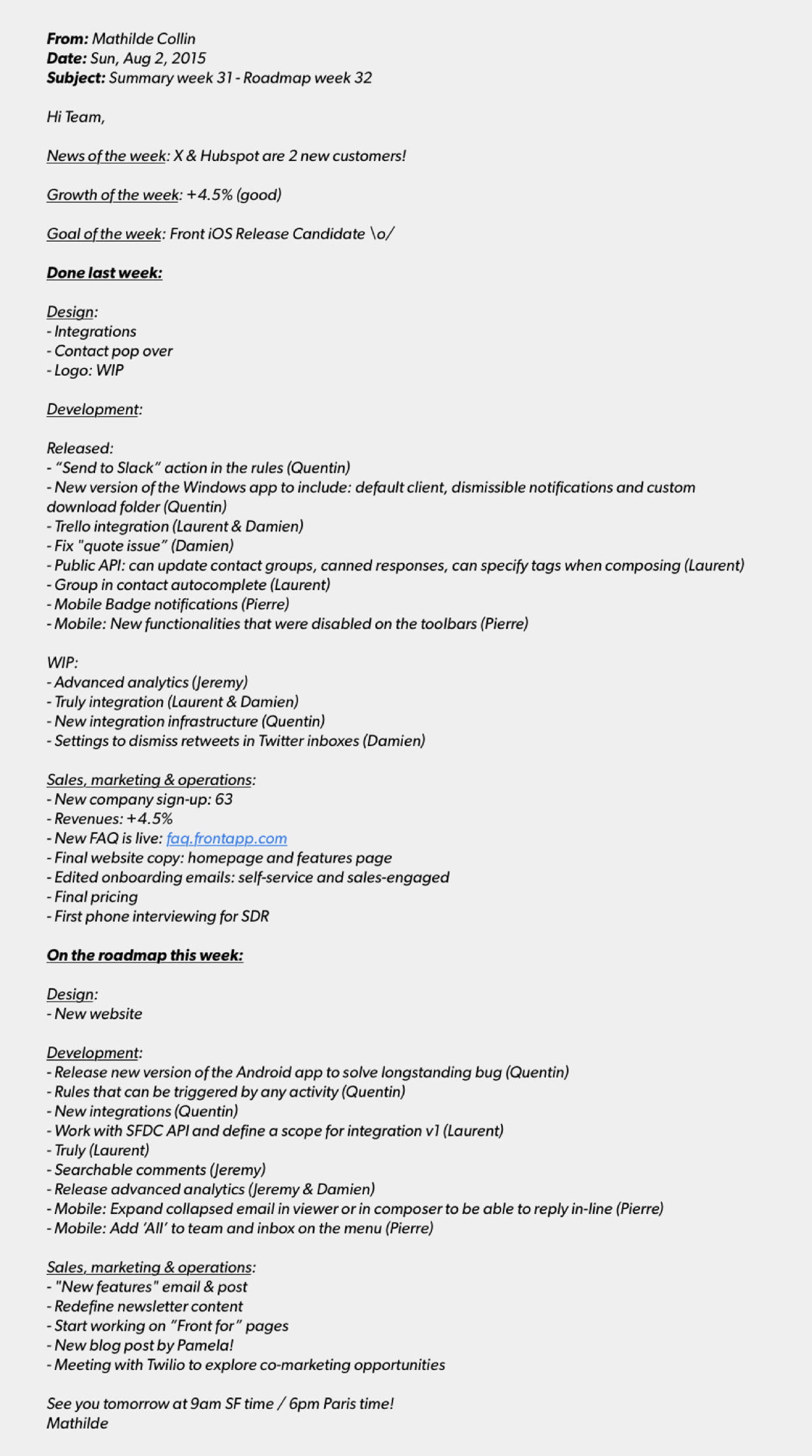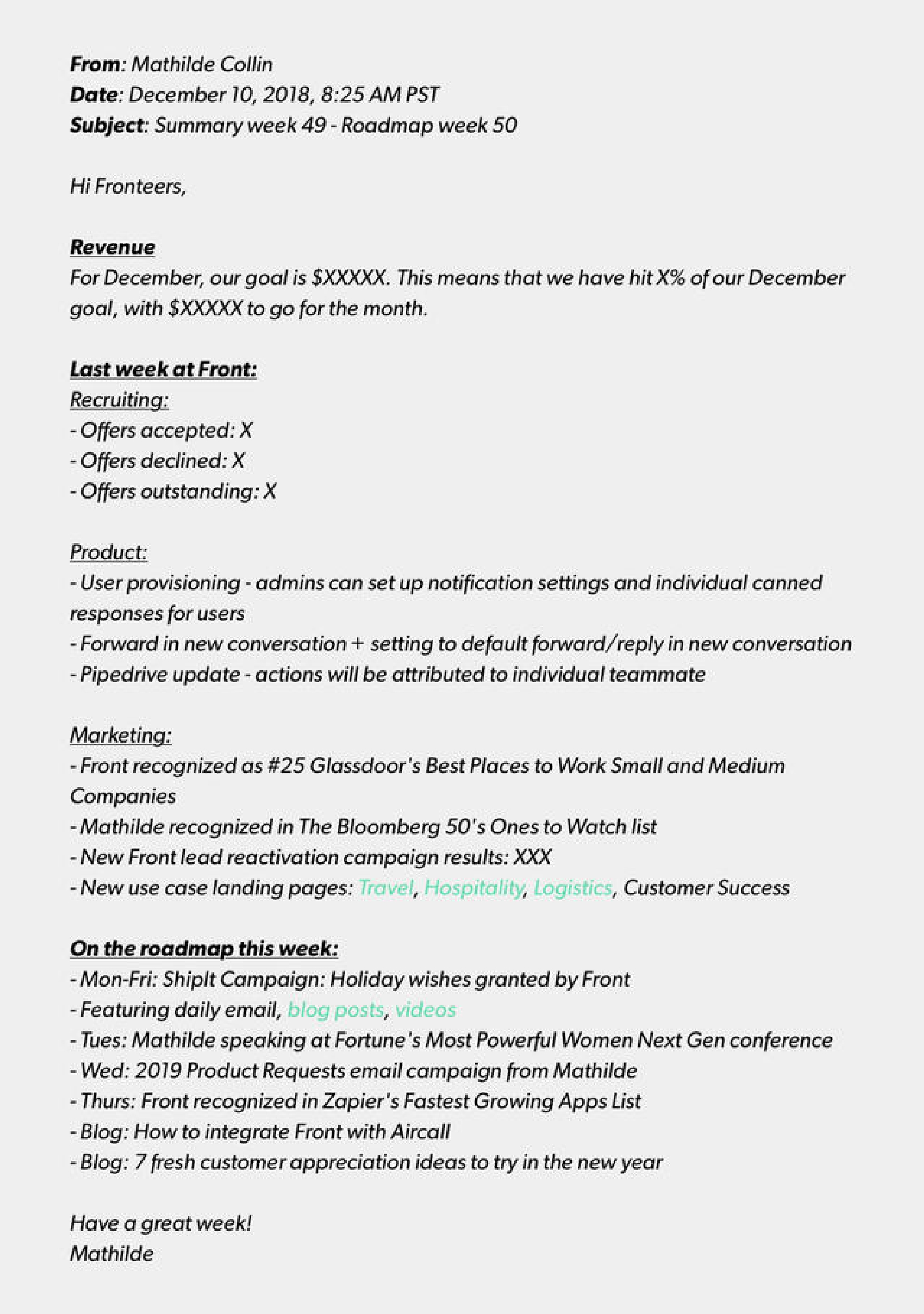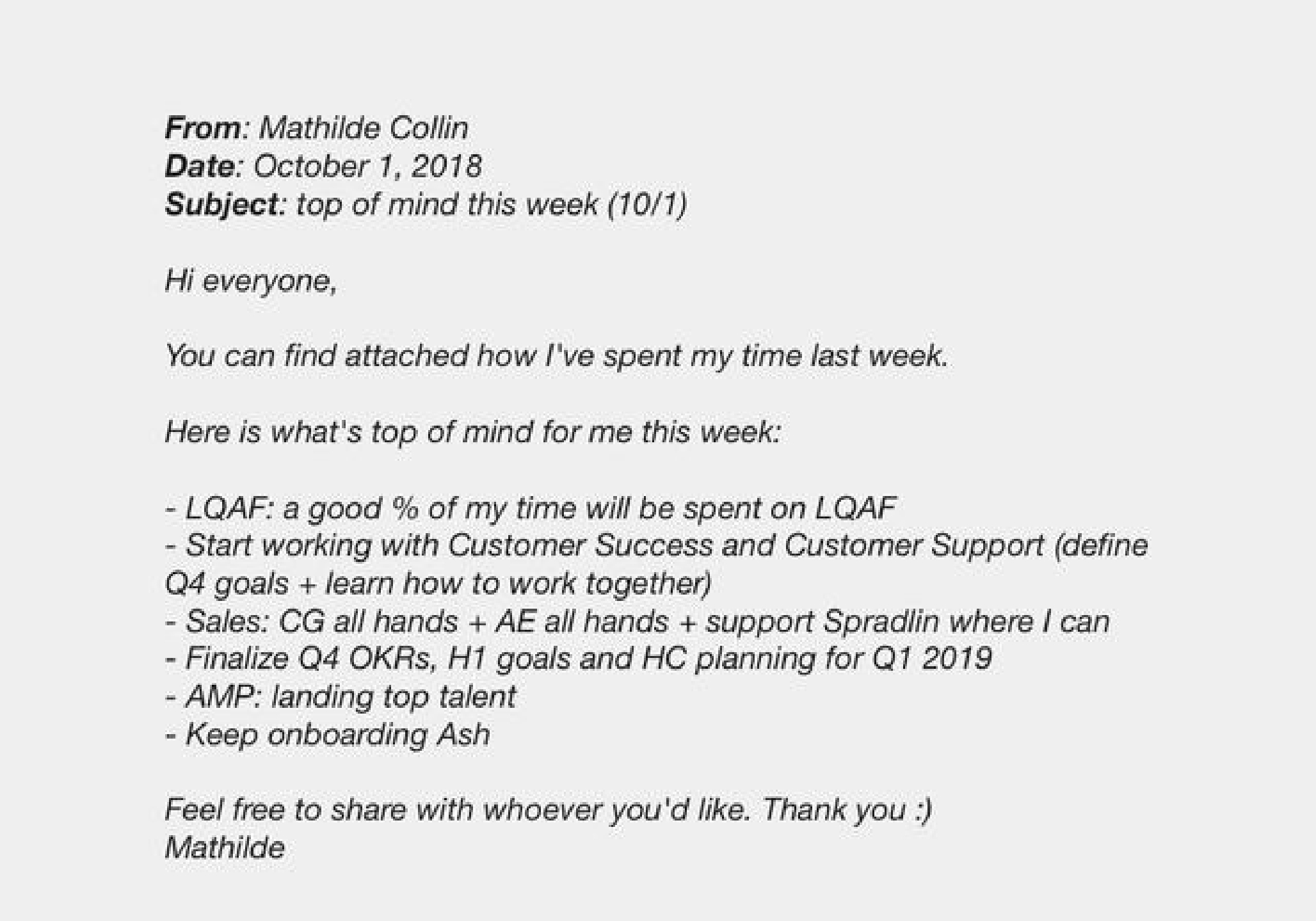When it comes to communications, founders are often laser-focused on the outward-facing victories, like securing a splashy podcast spot or landing the coveted cover story. But while earning external press helps to add a coat of polish to your brand, it’s the day-to-day work of internal comms that keeps the engine running.
When teams are in sync, it fortifies every aspect of company and product-building. Making sure that everyone understands what’s going on, the role that they play and how to prioritize helps your company speed toward its goals. It’s also the secret to employee engagement: When an employee feels bought in, informed and listened to, you’re far more likely to hold on to your best talent. On the flip side, when the internal communication lines are faulty, instability threatens the entire company. Neglecting to seek perspectives or clear misunderstandings can fan the flames of conflict, feed mutinous factions and spark product crises, among other common company-killing ills.
While putting intention and dedicated effort into communicating with your employees may seem like a “big company” task, the benefits of having a robust internal comms strategy (and the dangers of dismissing it) are even more marked for startups. While a maelstrom of changes can be easily communicated between a tiny founding team, as a team scales to five, six or seventy people, leaders need to pay even more attention to making sure that everyone’s rowing in the same direction — or risk capsizing as more folks climb aboard.
So how should startup leaders go about implementing a thoughtful internal comms practice? (Hint: it’s so much more than the occasional, slapdash All Hands). When we sifted through the Review for advice from founders, CEOs and comms experts, we found that in the most effective companies, internal comms is a two-way street: On the one hand, you need to deliver top-down messaging that’s crystal-clear and resonates with employees. On the other — and perhaps most crucially and most commonly overlooked — you can open up the opportunity for employees to give you valuable feedback from the frontlines.
The six practices and principles they share are designed to help internal communication flow both ways. They can be adapted to any scale, whether your company is lean and scrappy, large and established, or even distributed across time zones. From messaging sensitive executive transitions to combating PR wildfires before they even start, we hope they help establish trust and engagement among your most important audience: the one that’s already on your team.
1. Teach your leaders to fish (and other tactics to boost internal PR).
While Terra Carmichael has plenty of expertise on finding and pitching journalists, she stresses that founders would be well-advised not to pay short shrift to internal comms. “Employees really should be your number one audience, especially as you scale. It’s absolutely critical that you communicate with them authentically and often,” says the former VP of Global Comms at Eventbrite.
There’s also the added bonus that investing in internal comms can actually support your external PR efforts. “Tap into the vested interest that your employees have in your company to help you tell your story better,” says Carmichael.
Your employees are often your toughest critics. They will call bullshit on you faster than anyone else. So if your story is not resonating with them, it's probably not going to resonate on the outside.
But workshopping messaging isn’t the only reason why companies should look inward. The industry is peppered with studies and data around the importance of employee engagement, highlighting that perks and benefits don’t necessarily mean your employees are engaged or believe in your mission. Rather, a culture that is built on accountability, authenticity, clear goals and strong two-way communication is what goes a long way to keeping your team engaged.
Here are three strategies that Carmichael has used to double down on internal comms:
- Leave it to the pros. “After five years at Eventbrite, I finally hired someone who knew much more than I did and specialized in internal and employee comms,” says Carmichael. “We’ve seen a big difference, especially among leaders and mid-level managers who appreciate the efforts to help cascade communications throughout the organization.”
- Read all about it. “I’m a big believer in teaching leaders to fish. That’s why we’ve rolled out a weekly(ish) email for leaders at Eventbrite that summarizes all the things they need to be thinking about in terms of managing and messaging to their team. We break it down into a few sections: things to know, things to do, things to share,” says Carmichael. “It sounds simple, but let’s be real, leaders are an important and expensive investment, so you want to use their time wisely. Giving them the tools such as cliff notes and summaries of important matters not only helps them be better communicators, but it also enables a timely cascade of communications throughout the organization.”
- Find micro-moments to connect. Aside from company-wide touchpoints, it’s also important to create moments to connect in small groups. “We started a weekly coffee break with our CEO, Julia Hartz, where six people get to sign up to informally discuss a specific topic with her,” says Carmichael. “Not only does this give employees valuable face time with her, but it's also been fantastic for Julia because it’s a new way for her to talk to a broader cross-section of the team and get their thoughts on topics that are top-of-mind for her. She’s also able to get a pulse on how people of all levels of the organization are feeling and any concerns or issues that they bring up themselves.”
Just doing an all-hands or a town hall meeting once a month doesn't cut it anymore. Employees need to feel a deeper connection to you and the business.
Read more about the top comms mistakes that startups make — and how to avoid them — here.
2. Send these two crucial emails every week — no exceptions.
Every aspect of Mathilde Collin’s role as a founder is instilled with her ethos of discipline, and her internal comms practice is no exception. Since Front’s early days, the founder and CEO has sent the same two, carefully-constructed emails every week. One is an update to the entire company, and another is a note to her direct reports.
At first blush, the emails might appear like superficial updates. The key distinction is that Collin sends them with an almost frightening regularity. The cadence sends an even stronger message: By consistently identifying the company’s metrics of success and explicitly laying out the steps she’s taking to move the needle, Collin sets a powerful example of accountability and metrics-driven leadership, from the CEO down to everyone else in the company.
Bring regularity to your team touchpoints to make sure they aren’t a one-off initiative from HR or a tradition that dies out — create something employees can count on.
Read on for a closer look at how she crafts her weekly emails and why they’ve been critical to Front’s results.

TO: All Users SUBJECT: Revenue update
As with most startups, Front’s early days were marked by an obsession with revenue. “We had no excuse if those numbers weren’t trending upwards. So I started sending a daily email to the team to bring that metric front and center. It explained how much revenue we added yesterday, what we did well and what didn't go so well,” says Collin.
“I soon changed it to a weekly email as that was a better cadence, but ever since I’ve sent this email every single week to our entire company. It always has the same structure and is sent around the same time. I haven’t missed a single one in the past four years,” she says.
“In the first few years, I wrote this completely on my own and it probably took me about an hour,” says Collin. “This may seem like a lot of time for an early-stage founder to spend on an internal note every single week, but it was vital. Amid all the growing pains, people knew exactly what success meant and evaluated everything they did through the lens of ‘How can we make that number go up?’”
SENT FOLDER: Below you'll find an early example of the weekly emails Collin sends to the Front team.

SENT FOLDER: Here’s a more recent, real-world (and lightly scrubbed) example of how Collin's weekly email template has evolved over time as Front has scaled.

For Collin, there’s power — and pressure — from this kind of transparency. “Sharing the good, the bad and the ugly provides accountability and a forcing function. If you see numbers that are less than great, you’ll be tempted to make an excuse, point to another bright spot, or hold off on sharing until things improve,” she says. “Or you might shift gears and work on another project as a distraction. But you can’t afford to do that.”
TO: Direct reports SUBJECT: Goals for the week
As another exercise in accountability, a different email flies out of Collin’s inbox at 10am sharp every Monday morning: a note to her direct reports.
“I quickly run through all of my goals for the week. It’s not about telling your reports every single thing you’re going to do. Rather it's a chance to share what’s top-of-mind for you, which of course should be top-of-mind for them. More generally, it’s helpful to know how managers spend their time — often it’s more of a black box instead. That’s also why I’ve made my calendar public and shared a deck that explains what I do all day as CEO of Front,” she says. This email habit also sets an example. “If I start to slip or if my weeks don’t ladder up to those big goals we’re focusing on, that sends the wrong message,” says Collin.
SENT FOLDER: Below is an example of Collin’s direct report email in action.

Read more about the Front founder and CEO’s guide to discipline for founders here.
3. Set out the welcome mat for exploration and host Open Houses.
As the former Head of Internal Comms at SoundCloud, David Noël was tasked with a daunting mission: to facilitate seamless collaboration for over 300 employees across four offices (Berlin, London, New York and San Francisco) in four different time zones.
The result has been some groundbreaking thinking around culture and communication. A few years ago, he shared an unconventional meeting format that’s helped him build a world-class internal comms program: it’s called the Open House, and it can be successfully scaled down for startups in single time zones, too.
While All Hands meetings are vital for bringing transparency to big company-wide initiatives, Noël began to observe a trend happening after the All-Hands: a few employees would get to talking over lunch about an issue that’s only relevant to a certain subset of employees. He noticed that there are plenty of niche or smaller topics that deserve attention but don’t require an all-team meeting.
Enter Open Houses: smaller, informal meetings that anyone could announce and set up via the company’s internal messaging platform. “There’s so much going on at SoundCloud. Email and documentation aren’t always the best ways to engage around a topic that is dynamic and exciting,” Noël says. When a company is small, it’s easy to get information informally, over a meal or during a hallway chat. But as a team grows, these lines of communication can break down. “Open Houses provide a way for people to stay informed about all of the things they choose to care about.”
Here's the important thing: The Open House format is flexible. Some people do a straight Q&A session, while others use slides to provide context for the discussion. A few examples of the types of material that work well in an Open House include:
- The insights and data teams presenting findings about an intriguing user segment.
- Early prototypes or wireframes the design team is enthusiastic about.
- Recent user research that is telling or surprising collected by the data team.
- Progress toward a big launch as told in narrative form by the product team.
Open Houses are also used to reinforce the most important themes coming out of All Hands meetings. For example, the first All Hands of every quarter is dedicated to high-level goals, plans and objectives for the next 3 months. This is often followed by an Open House for anyone who wants to dig deeper into these topics.
“We make very clear what each Open House is about when we send out the invite,” says Noël. “Is this more directed at engineers or marketers? What are the objectives? We want to make it easy for everyone to make a quick decision about whether to attend.” He points to two specific ways Open Houses have already helped increase engagement for the SoundCloud team:
1. Building connections across multiple offices. “Open Houses are an easy way for people to learn about something from a team that they never normally see. When I’m in the San Francisco office, I always host an Open House there about what I'm up to. The questions are always different from the ones I get in Berlin. It’s a good way for me to help connect the dots and tap into topics that are top of mind in that office. It often brings up ideas and questions I haven't considered but that I should.”
In general, SoundCloud employees (especially senior managers) are highly encouraged to travel to the other offices to promote face-to-face communication, context-setting and to help more people connect the dots across the company. In fact, the company offers a Global Exchange Program where employees can apply to work in another office for a quarter if it will add value to their development or output. It's turned into an incredibly popular program that employees cite as a key perk.
2. Giving more people a seat at the table. For example, SoundCloud recently developed its internal action plan around diversity and inclusion. “On the road to defining that plan, we had at least one Open House in each office for people to provide input on what we should be focusing on as a company,” Noël says. The people hosting the Open House are often the resident experts on that topic or area, but they're encouraged to draw in anyone who simply wants to learn more who may then be tapped to present or ask specific questions so that everyone can benefit from the information shared.
Open House meetings have quickly grown in popularity at SoundCloud, proving their value for keeping knowledge flowing, current and nimble. “The sheer number of Open Houses being organized in every office in an indication of how useful people find them. If we see a topic bubble up that seems to justify an Open House, more often than not there will be a packed room.” And if multiple Open Houses get organized around a particular subject, Noël's team perks up and considers adding it to the next All Hands docket. They're not only good for sharing information — they help the company keep its finger on the pulse of what inspires people, what they care about.

4. Don’t shy from contrarian opinions and candid feedback — invite them to the table.
The tech industry is littered with examples of communication breakdowns that stunted promising starts. Suddenly problems got too unwieldy, people didn’t know what was going on and products suffered. Back when he was CEO of URX, John Milinovich was determined to dodge this bullet by building a shatter-proof internal comms strategy.
His call paid off: In 2016, URX was acquired by Pinterest. Milinovich has since joined the ranks of repeat founders and is now CEO of Plato.
Below, he shares one internal comms strategy he deployed while scaling URX to boost transparency and embrace feedback — the good, the bad and especially the ugly.
It’s called Contrarian Office Hours. It arose as John and his co-founders decided they needed a forum for employees to share constructive criticism not just with team members, but for the company as a whole. Every Friday afternoon, the entire team gathers together, and everyone is invited to share ideas, air grievances, ask questions, and say outright that they think things should be done differently. The word “contrarian” was chosen specifically to draw out arguments and hot-button topics. In Milinovich’s words, “It creates a safe space where people are not just allowed to mix things up, but given express permission to call things out. It also primes people to not take things personally.”
Contrarian Office Hours have been used to tackle everything from whether URX should work with a specific customer, to equity packages and vacation policies. Allowing people to step out into the open and talk about how they feel has both helped them bond and accept ownership over the company.
The best organizations are the ones that not only solicit constructive feedback, but actually do something with it.
“We tell our employees to check their egos at the door, so as a company we need to do the same thing,” Milinovich says. Part of the deal is that URX’s leadership will take whatever’s thrown at them and meaningfully respond (even if it requires extra research or a product change).
“We want people to know that when they go into that room for office hours, they can express how they feel, but no one is being attacked personally. It’s all about building the best company possible,” he says. “For example, we had one person say that they feel awkward taking vacation because the founding team never takes time off and we didn’t have a well-defined requirement. We followed up by asking who else felt the same way, and scheduled time with them to create a concrete policy. It let us have the people who were most passionate about the issue involved in coming up with a solution.”
The session is time-bounded to an hour, so that people with questions or opinions are encouraged to share upfront, and people with answers are incentivized to fix issues swiftly if they can or take more complicated matters offline.
The leadership team actually collects questions and topics in advance, so that they can prepare genuine, thorough answers, and also budget how the time will be used. “If we know we have 10 questions, we’ll pay attention to handling each in five or six minutes,” Milinovich says.
Every issue raised during Contrarian Office Hours is logged on URX’s internal wiki — a forcing function to find answers, take action, and keep people accountable for making changes. As things get done, their status is updated and eventually marked as complete. This is visible to everyone within the company. “No matter who you are, you can see who is assigned to a specific action item and whether they did what they were supposed to or not.”
Contrarian Office hours have also played a major role in initiating new hires into URX’s feedback-fueled style. Recent recruits are required to attend during their first week, and Milinovich says he knows its having the desired effect. “People who just joined start participating right away. It’s incredible to see someone who has fresh eyes come in and feel comfortable asking why things are the way they are. When this started happening, we knew that this would become and stay a cornerstone of our culture.”
Also critical: Contrarian sessions end by celebrating victories large and small. Milinovich quickly realized how necessary this was to end the week on a positive, energizing note. No matter how negative the preceding hour can get, this gives people a chance to share personal wins, congratulate their colleagues, and recognize good work. Stacking criticism and praise so closely together has had a compound effect, he says: It has made transparency rewarding.
5. Prevent communication wildfires by creating a culture of preparedness.
When it comes to tackling comms conflagrations, Krista Berlincourt is a seasoned firefighter. Her resume has spanned stints driving Developer and App communications for Microsoft’s Windows Phone, leading communications at fintech startup Simple and, most recently, embarking on a new journey as a founder.
In Berlincourt’s experience, the key to navigating disaster is laying the groundwork for crisis management before anything catches fire. She shares the internal comms practices she used at Simple to foster a culture of preparedness — inspired not only by her experience, but by the National Forest Service’s methodology for tackling real-life fires.
If luck is what happens when opportunity meets preparation, a crisis is difficulty meeting unreadiness. You can’t avoid every iceberg, but you can add a few more safety boats.
Flag early, flag often.
Only you can prevent forest fires. The same goes for brands. Build a culture where every contributor is not only empowered but encouraged to raise their hand when something seems to be going awry. “If you smell smoke, say something. We ask every member of the Simple team to flag incidents, and describe, not analyze them,” says Berlincourt. “For example, the best outcome is that they raise their hand and say, ‘Hey, I noticed this customer issue,’ or ‘We seem to be outpacing forecasted onboarding volume and applications are taking longer to process.’ We do this in a dedicated Slack channel. Then, a segment of the team will field, classify, and triage each issue with support from a technical team, as needed. More often than not, the smoke is eliminated before fire catches.”
Simple’s engineers introduced the U.S. Forest Service's model for incident classification. “It’s National Fire Danger Rating System is accessible and straightforward. The alerts begin with green, but any color beyond green is an incident. If there’s even an inkling from a ranger or the public that something’s afoot, it’ll raise the alert, even if there’s not an immediate action to take. There’s a sensitive trigger with information, but a more deliberate one with action,” she says.
“The beauty of this color warning chart is that its basic categories are commonly-known and established, but are retrofitted for specific regions. For example, the Forest Service worked with a local agency in Southern California to develop an additional color warning to better assess the risks specific to that region. In the same way, companies should adjust their rating systems to best suit their risk tolerance given factors such as company-stage, industry and customer base. For Simple, which deals with banking and personally identifiable information, it’s flag early and flag often.”
Flag early, flag often. Otherwise, what a bucket of water would’ve doused yesterday takes 100 firefighters to fix today.
Thanks is the only answer — and last word.
What most crisis communication systems neglect is closing the loop with colleagues in the same careful manner as they do with their customers. “To build a culture that supports an effective crisis communications system, you need to thank each and every person who flags an issue,” says Berlincourt. “Even if it’s a false alarm or a blip, it's really important to meet them with compassion, and say, ‘Hey, thank you so much for flagging this, I think we're going to be okay, but we'll keep an eye on it’ as opposed to ’Why would you think this was an issue?’”
This tenet builds on a culture that would rather respond to every shout from the boy who cries wolf than get devoured unaware. “It's a cultural issue. If you have an environment where you even implicitly require 100% success, raising your hand becomes high-risk. In those cases, you’re going to feel the flames before you see the fire, because no one will tell you,” says Krista. “It’s the people on the frontline who see the most, right? For consumer tech companies, the front lines are fueled by customer service reps who may be new to the business. If they’re reluctant to raise their hand because bureaucracy will smack them down, don’t be surprised if an incident develops before you’re aware of it.”
Read more of Berlincourt’s wisdom how to save your startup from a communications crisis here.
6. Manage top-down decisions and transitions with compassion.
At some point, every startup will have to undergo a major transition, whether that involves a new strategic course or a change to the executive team. When Sasha Orloff made the decision to step down as CEO of LendUp, he knew that he had to perfect the internal messaging before he made the announcement to the rest of the company.
“Whether you’re stepping down or marking another change in your company’s direction, take care with your messaging. There should be almost an excess of intentionality around transitions,” says Orloff. “Any kind of transition is bound to make people uneasy, because change is frightening. With a founder stepping down, employees and investors reasonably wonder if there’s some uncomfortable dynamic or ominous future behind the curtain.”
The stakes were heightened for Orloff, who was both LendUp’s CEO and founder. “Unlike a massive enterprise, where professional CEOs come and go, a founder CEO’s transition carries far more emotional weight. On top of that, once news gets out, the story can take on a life of its own on Twitter and beyond. Your internal communication strategy is your opportunity to take control of the narrative, right from the beginning.”
He shares his step-by-step guide for messaging a major top-down transition, with anecdotes from his own experience:
- Take time to plan your rollout. “The longer you plan in advance, the smoother the transition will be, and the higher your likelihood of finding the best replacement. I discussed it with my cofounder first, then planned the messaging privately with the board and the head of comms six weeks in advance. We iterated on how to share the news, to strike the right tone and give enough context.”
- Give opportunities to reflect and react. “We were definitely intentional about timing the announcement to leave people plenty of space to process and ask questions. I didn’t want to say Enjoy Friday afternoon everybody, and by the way, I’m stepping down as CEO! That would be a terrible; you don’t want to put your employees in that position. So, we made the announcement on a Wednesday, and I devoted time for a Q&A. On Thursday, we did a lunchtime Q&A, and I answered questions that people had anonymously sent in. On Friday, we had an all-hands happy hour, where I said good-bye and answered lingering questions.”
- Be a human about it. “I had initially drafted an email to send to the entire company, but I ended up reading it at an all-hands. Or at least trying to. I think I made it a few sentences before I started to get choked up and tears started flying — and I almost never show emotion. Someone had reminded me, ‘This isn’t a time to be stoic.’ When you’re transitioning, it’s okay to show your emotions and be vulnerable. It’s okay to be sad and excited for the future. During that Friday happy hour, I made sure I was wearing my LendUp shirt, to signal that I would be involved as a board member and still cared a lot about the company.”
Read more of Orloff’s wisdom on career transitions — garnered over the course of 100 coffee chats.
